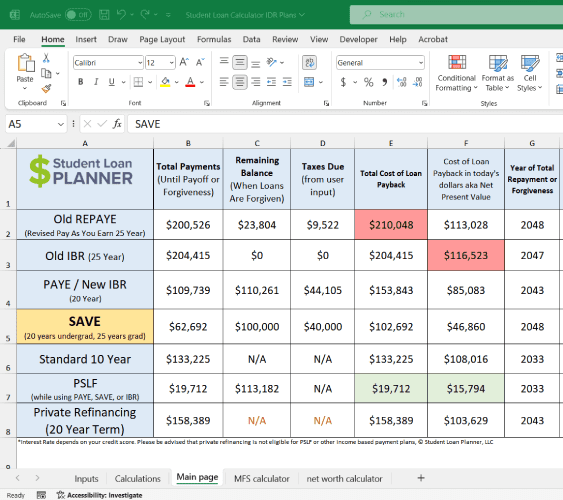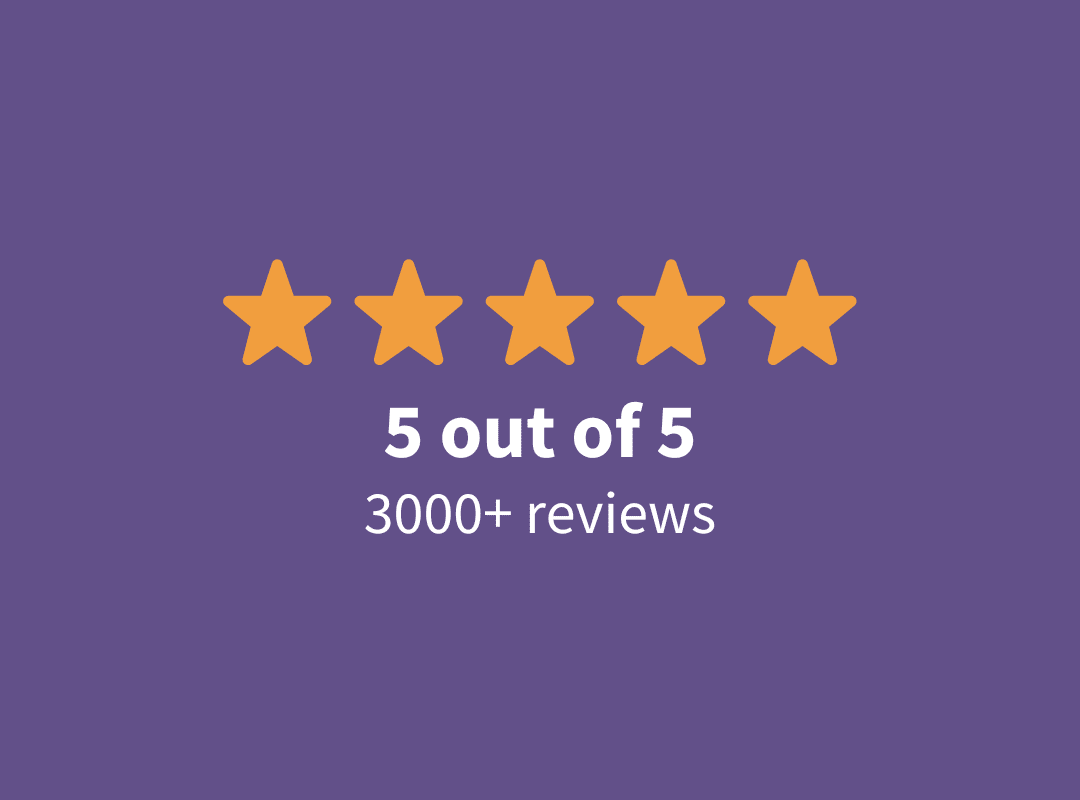
Former President Donald Trump didn't win reelection in 2020, but there might still be some lingering fears surrounding efforts to repeal the Public Service Loan Forgiveness program (PSLF) in the future.
His repeal proposals were always limited to borrowers who haven't taken out student loans yet. His budget also included plans to eliminate REPAYE, PAYE, and IBR and replace them with a 30-year version of IBR.
Although he's no longer in office, a future Republican Congress could eventually try to repeal the PSLF program. But they'd likely grandfather current borrowers who have PSLF in their promissory note.
Here are my latest thoughts on efforts to repeal PSLF.
Get Started With Our New IDR Calculator

What happened with Trump PSLF repeal attempts?
Clients flooded my inbox with questions asking about the Trump administration's plans in regards to the PSLF program.
For those who don't know, PSLF allows federal student loan borrowers to work for a nonprofit employer for 10 years and receive loan forgiveness that's not considered taxable income. For many borrowers burdened by huge amounts of student debt, student loan forgiveness eligibility is their only hope.
Trump's administration didn't end up repealing PSLF. But that doesn't mean there won't be future attempts by like-minded politicians.
Here's how you should prepare your finances if you're worried about PSLF being repealed.
Act like repealing PSLF isn't going to happen
I had an interesting conversation with a client before the presidential election about their $200,000+ student debt balance.
She had the ability to refinance and was incredibly worried about Trump repealing PSLF. Hence, her thought was why not go ahead and lock in a lower interest rate and pay everything off.
Otherwise, she would have to take her chances with whatever the new administration will do over the next 10 years of student loan payments.
If she stays on PSLF and files her certification paperwork, she's on track to save about $200,000 through debt cancellation. If she refinances and avoids waiting around 10 years to find out PSLF doesn't exist anymore, she could save about $50,000.
Let's think about this scenario like I would as a former bond trader. One outcome gives you savings of $200,000. The other outcome gives you savings of $50,000. The two options are mutually exclusive, meaning PSLF can't exist and not exist at the same time.
Therefore, if I wanted to decide what to do, I would multiple each of the numbers by the probability of each event and sum them.
What is the PSLF repeal probability?
PSLF is almost certainly going to be repealed or modified in some way at some point. That change just won't affect graduates or anyone currently pursuing the program.
One proof point is the way the US reforms social safety net programs like Social Security. The discussion centers on altering the rate of growth of future benefits. No politician wants to commit political suicide by reducing current benefits for beneficiaries today.
Let's look at some PSLF-related proposals in recent years.
The 2015 Republican PSLF repeal plan grandfathered in anyone who currently holds federal student debt. It also allowed students enrolled in degree programs at the time of the repeal to continue borrowing PSLF eligible loans until they graduated.
The Democrats also effectively proposed their own repeal plan in former President Obama's budget around the same time. He tried to limit PSLF to $57,500. That effort failed due to resistance in his own Democratic party.
Then in January 2017, Republicans had all the levers of power. Yet, they failed to repeal PSLF.
And most recently, the Biden administration is pushing to expand student loan forgiveness programs. Other significant details of Biden's federal higher education policy proposals include:
- Allowing bankruptcy discharge of student loans
- Reducing income-driven monthly payments that would be based on 5% of a borrower's discretionary income
- Increasing federal student aid through Pell Grants and supporting funding for Historically Black Colleges and Universities (HBCUs) and other other minority serving institutions
- Making four-year public colleges and community colleges tuition-free
- Excluding loan forgiveness from taxable income
- Canceling $10,000 of student debt for borrowers through legislative action
Keep in mind that these items are just proposals at the moment. But for now, borrowers can take comfort in knowing there will likely be PSLF improvements under Biden's plan, rather than destroying it under Trump PSLF plans.
Remember that PSLF changes would have to happen from an act of Congress with some measure of bipartisan support, not just because a president wills it.
Calculate the expected value of staying on PSLF
Going back to the earlier example, say you have $200,000 of savings under PSLF. Alternatively, assume you would incur losses of $50,000 if you remain on the federal loan system and accrue unnecessary interest.
After all, you can refinance your student loans and save money otherwise. With my probabilities, the expected value of staying on PSLF is $200,000*0.85+(-$50,000)*0.15=$162,500. Even if the probability is 50/50, staying on PSLF has a positive expected value.
Therefore, if you're looking at PSLF logically as an investment professional would, you need to be staying on the program if your savings are significant.
Prepare like repealing PSLF is happening tomorrow
Prepare your finances just in case PSLF repeal becomes reality at some point down the road. It's very unlikely to affect you if you already have debt.
Borrowers in pursuit of PSLF fall into two camps. The first group could pay their student debt off if they wanted to. They're pursuing PSLF because it's a better financial decision, not because it's their only option.
The second group can never repay their student debt due to economic hardship or huge grad or undergraduate loans. They would need to use income-driven repayment (IDR) 20-year debt forgiveness in the absence of PSLF.
Borrowers in the first group will have debt-to-income ratios below 2. They will refinance their loans and pay back their debt if PSLF went away.
Borrowers in the second group will need to focus on saving and investing more in retirement and mutual fund accounts if PSLF disappears.
What we've found after creating thousands of customized student loan plans for borrowers like you is that your savings rate matters far more than what happens with your student loans.
Set yourself up for success regardless of what happens with PSLF
Repealing PSLF would be bad news for a large number of borrowers. That said, it doesn't have to be a disaster. Plan for PSLF with your loan repayment strategy. Fill out the PSLF certification form. Maybe consider submitting it every six months instead of every year.
If you stop building progress towards tax-free loan forgiveness, you're giving up the potential future savings that could very well happen. We're all probably going to be dealing with higher tax rates in the future anyway, so you might as well get all the benefits you're eligible for.
Hedge your risk against PSLF repeal. Save aggressively outside of your retirement plan. If PSLF changes, then you can retool your loan strategy accordingly.
Are you worried about PSLF being repealed by the federal government? Share your thoughts in the comments.
P.S. If you are facing a six-figure student loan burden, check out how we create “PSLF & PSLF backup repayment plans” for your student loans.
Not sure what to do with your student loans?
Take our 11 question quiz to get a personalized recommendation for 2024 on whether you should pursue PSLF, Biden’s New IDR plan, or refinancing (including the one lender we think could give you the best rate).

You mention the giant tax bomb at the end of twenty years. Income tax is only owed on the amount a borrower is solvent. There could be tax planning that allows a person to be insolvent or partially insolvent so that the tax implication is not a 35%. For example, if PSLF is cancelled, I may have $600,000 in loans forgiven after 20 years. However on the year they are forgiven, I may have a home loan, car loan, and credit cards of $300,000 and assets totaling $500,000. Therefore my debt is $300,000+$600,000=$900,000 and my assets are $500,000. Therefore I am insolvent by $400k and I only would owe taxes on $200k. That is if the government doesn’t make student loan forgiveness I taxable by then.
I’m not a CPA Nadine, so let me say that first. If you are or have an accounting legal background would love for you to expand upon insolvency rules. Student loan forgiveness is already taxable income under the current IRS rules, of course we’ve yet to see anyone actually had loans forgiven yet so it’s anyone’s guess what will occur.
Hi Travis-
I have my undergrad in accounting and MBA but am not a CPA. However, I have learned about insolvency through my experience in 2012 when I had a business go under and a few rental properties foreclose. I only owed tax on forgiven debt up to the amount I was solvent. I think a CPA would be better suited to give official advice, but from my research I feel confident in the insolvency exclusion. Now it doesn’t work for everybody because many people will have far more in assets than debt in twenty years, especially when considering inflation. But this is a backup plan for savvy folks on the 15% chance of PSLF screw-age. Specifically for people who are married such as myself, in a time tested trusting relationship- my husband can hold assets in his name, and I am not in a community property state so they are treated separately. Here are some links, the first is most applicable to large six figure debts.
https://lawyerist.com/83690/defusing-student-loan-interest-tax-bomb/
https://cpawilmingtonnc.org/cancelled-debt-cpa-discusses-tax-consequences-of-student-loan-forgiveness-cancellation-and-discharge-insolvency-form-982-and-form-1099-c-from-92-instructions-form-1099-c-instructions/
Read IRC section 108 f (2). If you qualify for PSLF, (public service job), you qualify for that IRS tax exclusion. Layman’s terms = you won’t owe taxes on the forgiven debt:)
Have you seen the latest bill? They’re repealing it in its entirety as well as the forgiveness for income based borrowers after 20-25 years. PSLF is written into the promissory note we all signed. How can they do this for us in the program?
Right but only for borrowers who take out loans for the first time in 2018 or 2019. Others are grandfathered in. So you should be ok.
I’m in my master’s program now, set to graduate May of 2019. This article mentions “Rising first year grad students in fall 2017 and spring 2018 are most likely safe.” which I fall into this category. Right now my loans are in deferment since I’m in school, so I’m not technically signed up for PSLF, but this is how I anticipated paying my loans off.
My question is how am I safe, or how could I be grandfathered in if I am not technically paying on my loans yet? I
You will probably be grandfathered in based on the current text of the bill.
Can you clarify whether or not current PSLF candidates will have their REPAYE/PAYE plans cancelled and automatically changed to Trump’s new IBR plan that will definitely increase eveyone’s monthly payment? So, we’d be grandfathered in for PSLF, but in turn our monthy payment goes up. Thanks!
Well the current bill they’re debating would actually keep the payment amount the same as it is under REPAYE / PAYE, but worst case seems like an increase in payment amount is the worst thing that would happen
Could I meet with you to make sure my daughter is on track for pslf?
Sure Lisa check out our consult page here https://www.studentloanplanner.com/hire-student-loan-help/
I am worried because my debt is so high, and I am currently in IDR and loan forgiveness. At the rate we are paying, we will never touch the principal balance. So if in a few years they cancel, I will be even more behind and probably won’t catch up. Do I just stay in forgiveness and hope or cancel and start paying it in full? I also don’t know if I can afford to pay it in full with a family and three kids. Thanks for the advice!
Definitely stick with forgiveness if you qualify. I don’t think the program will go anywhere for quite a while (if ever).
Hi! Can you clarify what exactly grand fathered in would mean? Would that mean we continue to pay as we are now until they are forgiven?
Thanks!
Correct
Hello,
I am starting medical school July of 2020. According to what your staying, if the PSLF was repealed in say 2021, then would I still be eligible for forgiveness for all four years of medical school? That doesn’t really make sense to me.
It seems like ‘grandfathered’ people would be physicians who started their residency at a non for profit in 2020 and started making payments before the plan was repealed.
Travis, do you have an answer to this question? I have the same question, though I am starting in 2021. If PSLF is repealed in my second year, for example, would loans I take out in third and fourth year qualify? I know this is speculation, and highly unlikely with the current administration, but would appreciate an answer in accordance to how past proposals were written.
Hey Rob and Ashley, sorry for the delay here! Here is what our consultant Molly has to say: PSLF is not likely to be repealed in a Biden White House. Even efforts to limit it during the Obama administration failed. That said, fears around PSLF should not preclude you from borrowing in the federal system. There are other options besides PSLF that we can model for you. In general, past proposals that have passed are friendlier to borrowers. It’s rare they will take things away because of the risk of public backlash, and I wouldn’t worry about it if I were you.
I am confused about the promissory note. Do I need to call the lender to ensure that this is written in the promissory notes for my loan. I have been out of college for 29 years. My loans were deferred for nearly 10 years due to me going to graduate school, having other debts, and trying to find a good job. I serviced my loans through Sallie Mae and later found that they did not accept the PSLF program. Soon after I had my loans transferred to FEDLoan Services but I lost all the time I actually paid on the loan with SallieMae. I started with FEDLoan 5 years ago. It does not matter how much I have paid on my loans they just don’t seem to go away. I left college with a $17,000 balance which has increased over the years due to the interest rate. I feel like my loans should already be forgiven. When you sign up for the PSLF do they write this in the promissory notes or is it something you have to request?
PSLF is in the Master Promissory Note since 2007. If you started with PSLF 5 years ago, you’re halfway there.
If I have been in the PSLF Program since 2015 does that mean I would grandfathered in?
I have been in the PSLF program since 2015 does that mean I would be grandfathered in?
It’s likely that’s what would happen but the details would probably change several times before it actually became a law.